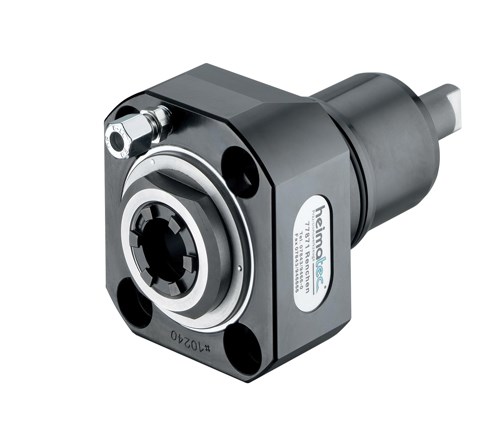Flexible, Quick-Change Tool Adapter System
Before the development of live tooling, there were turning centers and machining centers. Processing parts with multiple operations that included turning and milling required moving the workpieces from one machine tool to another.
Before the development of live tooling, there were turning centers and machining centers. Processing parts with multiple operations that included turning and milling required moving the workpieces from one machine tool to another.
Featured Content
Often, the difference in cycle times between a mill and a lathe results in an imbalance in the work flow. Moreover, reduction or elimination of part handling and re-fixturing of the work-in-process is a big driver for using live tooling on turning centers and for the development of multitasking machines.
Beyond the obvious advantages of a modular adapter system, including inventory reduction and overall cost savings, a shop needs to consider the following factors in determining the suitability of such a system. Owing to the physical design of the holder and especially the polygonal drive, there is a need for an extremely high power transmission factor, with no loss of torque.
Live tooling adapters should have a short and compact design, which allows a higher degree of flexibility in the tooling used. Close coupling of the toolholder and its mounting point also opens more options for the machine builder and end user alike.
Because of the nature of turn-mill applications, high bearing rigidity, whether in an axial or radial configuration, is necessary for high accuracy machining regardless of the operation being performed. With adapters allowing drilling, sinking, threading, milling or turning operations, the flexible adapter system gives a shop the widest variety of machining capabilities needed to remain responsive to changing workloads.
There are two other main considerations for shops looking to use live tooling in production. One is to have a tooling system with flexibility to take a variety of tooling shank types to reduce the tooling inventory of the shop. A second consideration is tooling that provides a quick-change connection between the cutting tool and the live toolholder for tool changes and job change-overs.
German manufacturer Heimatec Inc. has developed a line of live tools, angle heads and multi-spindle drill heads that fit these considerations. For adaptability, the company’s flexible tool adapter system, called U-tec, allows a standard ER output live tool to accept various adapters for different applications.
There is indeed a substantial long-term cost savings to the shop, since the same holder can accept either a standard collet or this flexible adapter system, which mounts with standard collet nuts.
This system allows machinists the ability to have quick change-over of tools on almost any lathe, using a single live tool, without having to commit to a quick-change system on the initial purchase. A face mill adapter can be quickly positioned into the standard holder, without the need for a completely new base installed. This significantly reduces inventory costs as well as change-over time for the busy shop.
This new system, according to Heimatec President Preben Hansen, “represents a real improvement in lathe and mill-turn tooling design. U-tec allows improved user flexibility, while a polygonal drive system ensures extremely high power transmission stability and faster setup with absolutely no loss in performance or accuracy, because the live tool base remains in position and only the adapter and collet get swapped.”
He goes on to explain the unique collet nuts on the U-tec system have internal threading for rigid mounting and that this new tool adapter system enables the actual cutting tool to be brought into closer proximity to the bearing, thus further improving performance in use. This benefit results from the short and compact tool length design. Internal coolant up to 2,000 psi (140 bar) is provided standard.
Every adapter in the U-tec system comes complete with any necessary clamping nuts and adapters are immediately available in face mill style, ER extensions, side lock, shrink fit, hydraulic and blank. This new tooling system is available for all major turning machines currently on the market.
For quick-change live tooling, the company has developed the HT series that also fits this bill. Using this new series, there is no need to change tooling. Only the adapter is removed from the tooling unit and that action is accomplished with a single clamping bolt. In this way, collet assemblies can be preset outside the machine tool and then simply swapped out as needed. It’s a fast and accurate means of getting back in the cut quickly.
Whether it’s a one-off job shop or long run production department, downtime on any machine tool is costly, and the HT Series reduces change-over from an average of 15-20 minutes down to about that many seconds. The tool head stays in the machine, so less probing is needed after the change-over, as well.
The HT Series offers a short gage line, which means minimum tool length consumed for a more rigid tooling setup. Coolant-through tool design is standard, and the system has repeatability to 0.0002 inch.
These tooling adapter lines are designed for shops serving the automotive, aerospace, medical, woodworking, composites and other industries, as well as an ever-increasing number of machine tool OEMs.
RELATED CONTENT
-
Bar Feeder Basics
Some primary factors are often overlooked when considering how to justify the implementation of a bar feeder for turning operations.
-
Advantages of Cellular Manufacturing
Manufacturing cells are used to minimize product movement as well as materials, equipment and labor during the manufacturing process. By reducing cycle times and material handling, these cells help shops more easily meet customer demands regarding cost, quality and leadtimes.
-
Making Micro Threads
Production of micro threads can be challenging, but using the most suitable tools for a given application can simplify the task.










